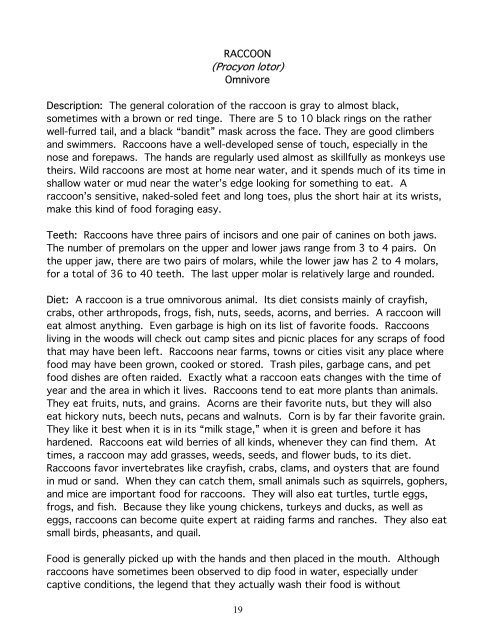TABLE OF CONTENTS - National Zoo
TABLE OF CONTENTS - National Zoo
TABLE OF CONTENTS - National Zoo
You also want an ePaper? Increase the reach of your titles
YUMPU automatically turns print PDFs into web optimized ePapers that Google loves.
RACCOON<br />
(Procyon lotor)<br />
Omnivore<br />
Description: The general coloration of the raccoon is gray to almost black,<br />
sometimes with a brown or red tinge. There are 5 to 10 black rings on the rather<br />
well-furred tail, and a black “bandit” mask across the face. They are good climbers<br />
and swimmers. Raccoons have a well-developed sense of touch, especially in the<br />
nose and forepaws. The hands are regularly used almost as skillfully as monkeys use<br />
theirs. Wild raccoons are most at home near water, and it spends much of its time in<br />
shallow water or mud near the water’s edge looking for something to eat. A<br />
raccoon’s sensitive, naked-soled feet and long toes, plus the short hair at its wrists,<br />
make this kind of food foraging easy.<br />
Teeth: Raccoons have three pairs of incisors and one pair of canines on both jaws.<br />
The number of premolars on the upper and lower jaws range from 3 to 4 pairs. On<br />
the upper jaw, there are two pairs of molars, while the lower jaw has 2 to 4 molars,<br />
for a total of 36 to 40 teeth. The last upper molar is relatively large and rounded.<br />
Diet: A raccoon is a true omnivorous animal. Its diet consists mainly of crayfish,<br />
crabs, other arthropods, frogs, fish, nuts, seeds, acorns, and berries. A raccoon will<br />
eat almost anything. Even garbage is high on its list of favorite foods. Raccoons<br />
living in the woods will check out camp sites and picnic places for any scraps of food<br />
that may have been left. Raccoons near farms, towns or cities visit any place where<br />
food may have been grown, cooked or stored. Trash piles, garbage cans, and pet<br />
food dishes are often raided. Exactly what a raccoon eats changes with the time of<br />
year and the area in which it lives. Raccoons tend to eat more plants than animals.<br />
They eat fruits, nuts, and grains. Acorns are their favorite nuts, but they will also<br />
eat hickory nuts, beech nuts, pecans and walnuts. Corn is by far their favorite grain.<br />
They like it best when it is in its “milk stage,” when it is green and before it has<br />
hardened. Raccoons eat wild berries of all kinds, whenever they can find them. At<br />
times, a raccoon may add grasses, weeds, seeds, and flower buds, to its diet.<br />
Raccoons favor invertebrates like crayfish, crabs, clams, and oysters that are found<br />
in mud or sand. When they can catch them, small animals such as squirrels, gophers,<br />
and mice are important food for raccoons. They will also eat turtles, turtle eggs,<br />
frogs, and fish. Because they like young chickens, turkeys and ducks, as well as<br />
eggs, raccoons can become quite expert at raiding farms and ranches. They also eat<br />
small birds, pheasants, and quail.<br />
Food is generally picked up with the hands and then placed in the mouth. Although<br />
raccoons have sometimes been observed to dip food in water, especially under<br />
captive conditions, the legend that they actually wash their food is without<br />
19
















